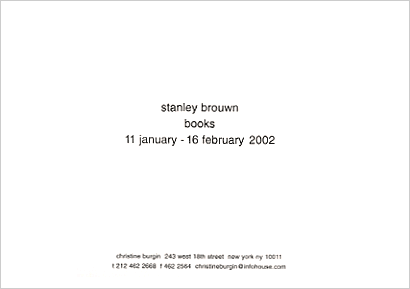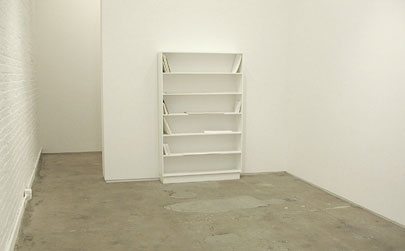
stanley brouwn
books
January 11 -
February 16, 2002
walk during a few moments very consciously
in a certain
direction;
simultaneously an infinite number
of living creatures in the universe
are
moving in an infinite number of directions.
stanley brouwn, art &
project bulletin 11, 1969
stanley brouwn has published books on a regular basis since 1970.
These books are an integral part of his work. For his exhibition at the Christine Burgin Gallery,
his first exhibition in a New York gallery in twenty-five years, brouwn has designed an installation
which consists solely of these books.
In New Art in the 60s and 70s (Thames and Hudson,
2001), Anne Rorimer situates brouwn amongst the group of artists -- Sol Lewitt, Hanne Darboven and
On Kawara -- whose serial based work of the 60s helped to define one of the key methodologies of
Conceptual Art. She quotes Lewitt's Paragraphs of Conceptual Art from 1969: "To work with a plan
that is pre-set is one way of avoiding subjectivity. Some plans would require millions of
variations, and some a limited number, but both are infinite. Other plans imply infinity." For
brouwn, the plan, which gives order to all, is the step.
stanley brouwn began working with
distance and direction in the early 1960s. During this period he made work by asking random
pedestrians to describe a route to another point in town. The resulting sketch or unmarked piece of
paper if the description were entirely verbal, would then be stamped This way brouwn. In the early
70s, brouwn began to make books. In one of his first publications, 100 this-way-brouwn problems for
computer IBM 360 model 95, brouwn lists this way brouwn questions to be posed to a computer
beginning with: "show brouwn the way in all cities, villages, etc. on earth from point x to all
other points in that cities, villages etc." Too complex for even a computer to solve, this list of
questions is designed to reveal the infinitely complex possibilities implicit in the idea of a this
way brouwn. In his book Steps, published by the Stedelijk Museum, Amsterdam in 1971, brouwn first
makes use of what would become a full-time focus for his work, his own footsteps: "from march 18
until April 19, 1971, I defined my total number of footsteps each day by means of a handcounter.
During this period I visited a number of countries where I had never been before. Consequently, my
footsteps there were my first in those countries." By 1976, brouwn has created his own unit of
measure, the brouwnstep which he makes use of in such publications as his 1976, 1m 1 step which
consists of two printed lines, one measuring 1 meter, the other 1 brouwn step. In recent
publications brouwn has expanded upon his interest in the use of the body as a means of measurement,
often making the basis of the work antiquated or ancient forms of body measurements such as the ell,
the foot and the Egyptian royal cubit. 
stanley brouwn
books,
2002
Installation view, Christine Burgin Gallery, New York